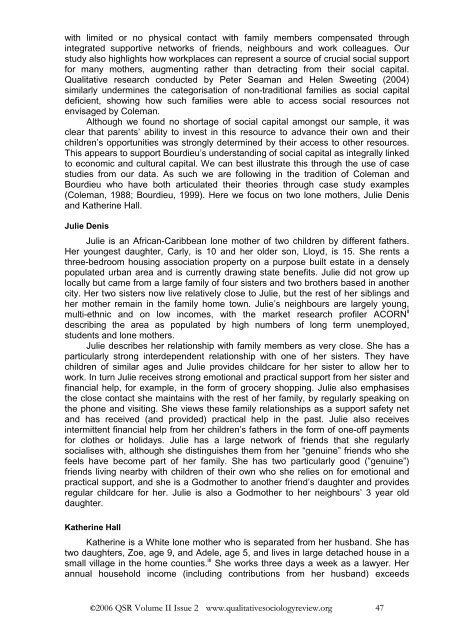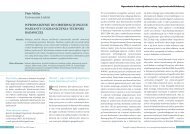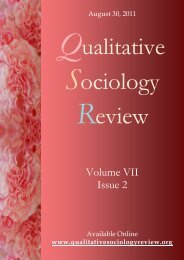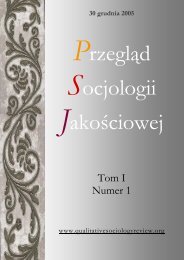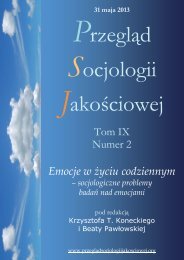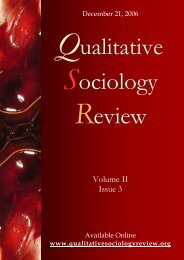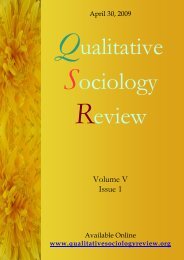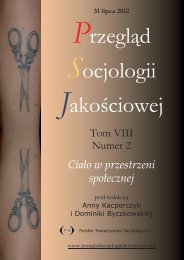Gillies, V. and Edwards, R. - Qualitative Sociology Review
Gillies, V. and Edwards, R. - Qualitative Sociology Review
Gillies, V. and Edwards, R. - Qualitative Sociology Review
You also want an ePaper? Increase the reach of your titles
YUMPU automatically turns print PDFs into web optimized ePapers that Google loves.
with limited or no physical contact with family members compensated through<br />
integrated supportive networks of friends, neighbours <strong>and</strong> work colleagues. Our<br />
study also highlights how workplaces can represent a source of crucial social support<br />
for many mothers, augmenting rather than detracting from their social capital.<br />
<strong>Qualitative</strong> research conducted by Peter Seaman <strong>and</strong> Helen Sweeting (2004)<br />
similarly undermines the categorisation of non-traditional families as social capital<br />
deficient, showing how such families were able to access social resources not<br />
envisaged by Coleman.<br />
Although we found no shortage of social capital amongst our sample, it was<br />
clear that parents’ ability to invest in this resource to advance their own <strong>and</strong> their<br />
children’s opportunities was strongly determined by their access to other resources.<br />
This appears to support Bourdieu’s underst<strong>and</strong>ing of social capital as integrally linked<br />
to economic <strong>and</strong> cultural capital. We can best illustrate this through the use of case<br />
studies from our data. As such we are following in the tradition of Coleman <strong>and</strong><br />
Bourdieu who have both articulated their theories through case study examples<br />
(Coleman, 1988; Bourdieu, 1999). Here we focus on two lone mothers, Julie Denis<br />
<strong>and</strong> Katherine Hall.<br />
Julie Denis<br />
Julie is an African-Caribbean lone mother of two children by different fathers.<br />
Her youngest daughter, Carly, is 10 <strong>and</strong> her older son, Lloyd, is 15. She rents a<br />
three-bedroom housing association property on a purpose built estate in a densely<br />
populated urban area <strong>and</strong> is currently drawing state benefits. Julie did not grow up<br />
locally but came from a large family of four sisters <strong>and</strong> two brothers based in another<br />
city. Her two sisters now live relatively close to Julie, but the rest of her siblings <strong>and</strong><br />
her mother remain in the family home town. Julie’s neighbours are largely young,<br />
multi-ethnic <strong>and</strong> on low incomes, with the market research profiler ACORN ii<br />
describing the area as populated by high numbers of long term unemployed,<br />
students <strong>and</strong> lone mothers.<br />
Julie describes her relationship with family members as very close. She has a<br />
particularly strong interdependent relationship with one of her sisters. They have<br />
children of similar ages <strong>and</strong> Julie provides childcare for her sister to allow her to<br />
work. In turn Julie receives strong emotional <strong>and</strong> practical support from her sister <strong>and</strong><br />
financial help, for example, in the form of grocery shopping. Julie also emphasises<br />
the close contact she maintains with the rest of her family, by regularly speaking on<br />
the phone <strong>and</strong> visiting. She views these family relationships as a support safety net<br />
<strong>and</strong> has received (<strong>and</strong> provided) practical help in the past. Julie also receives<br />
intermittent financial help from her children’s fathers in the form of one-off payments<br />
for clothes or holidays. Julie has a large network of friends that she regularly<br />
socialises with, although she distinguishes them from her “genuine” friends who she<br />
feels have become part of her family. She has two particularly good (”genuine”)<br />
friends living nearby with children of their own who she relies on for emotional <strong>and</strong><br />
practical support, <strong>and</strong> she is a Godmother to another friend’s daughter <strong>and</strong> provides<br />
regular childcare for her. Julie is also a Godmother to her neighbours’ 3 year old<br />
daughter.<br />
Katherine Hall<br />
Katherine is a White lone mother who is separated from her husb<strong>and</strong>. She has<br />
two daughters, Zoe, age 9, <strong>and</strong> Adele, age 5, <strong>and</strong> lives in large detached house in a<br />
small village in the home counties. iii She works three days a week as a lawyer. Her<br />
annual household income (including contributions from her husb<strong>and</strong>) exceeds<br />
©2006 QSR Volume II Issue 2 www.qualitativesociologyreview.org 47


